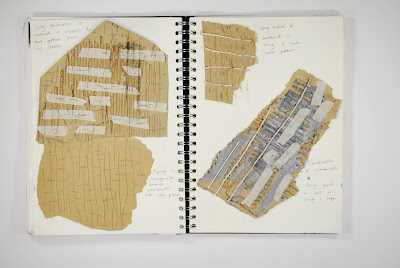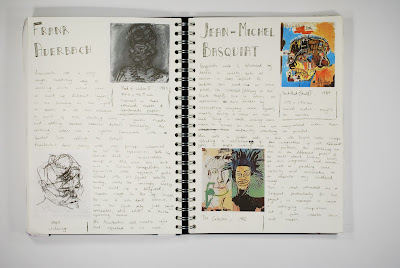The aim of this project was to explore and recognise the potential of working with clay by learning through experimentation. We were split into pairs and then we made groups of 6 (3 sets of pairs). Each pair was responsible for either the base, the middle or the top section of the tower - my pair and I were responsible for the base.
We had a lot of clay to work with and a lot of tools for making patterns, as well as coloured slip and grog. There were also oxides but there wasn't time for our group to have the oxide presentation so we didn't use them.
To start off the project we did some minor planning. As a team we decided to do our own thing with each section so that when we joined it up we would have a mish-mash of different textures and patterns together. After some initial planning with my pair, we decided to have a cube base and then as a group we decided to each follow a shape as a guideline, to provide some consistency to the tower. In addition to the base being a cube, the middle section was triangular and the top section was circular.
My pair and I started by cutting squares out of clay to construct the base cube. We used masking tape to make a square stencil on the clay and then coloured over it with coloured slip, to give a square pattern. We also tried using a plastic stencil with circles in it to add a circle-pattern but this was less successful as the slip went under the stencil and went quite messy. On the other squares we just used simple textures, such as a bumpy pattern which was did with a ridged-roller.
 |
| This is part of my sketchbook, showing some of the minor planning as well as some of the experimentation with the coloured slip and masking tape. |
To construct our base, we first rolled out the big logs of clay. We tried flattening the clay with our feet and then used our feet to roll the clay out. When the clay was thinner and more manageable, we used our hands to roll it out.
 |
| Me rolling the clay out with my foot |
To construct the cube, we used plastic tubes to act like scaffolding - it provided the sides of the cube with some stability while we joined it all together. We scored the sides with a knife and then applied slip to stick it together. We then smoothed the edges on the top and outside together. On the inside we pressed small strips of clay into the edges and smoothed that out.
 |
| Constructing one of our base cubes using the plastic tube |
We used a variety of different textures for our cube, loosely following an industrial/natural theme that my pair and I adopted. We used the geometric square shape, an imprint from a metal door and ridged/patterned rolling pins to act as 'industrial' patterns. We used leaf imprints, bark imprints and grog to act as 'natural' patterns.
To help me with this project I researched four artists; Jenny Beaven, Hans Coper, Gordon Baldwin and Paul Soldner. It was Beaven's and Baldwin's work that particularly appealed to me, with Beaven representing a 'moment' through several layers of texture and Baldwin deconstructing simple shapes into more interesting, abstract forms.
 |
| Some of my artist research from my sketchbook |
Unfortunately we didn't have enough time to fully construct our tower as we had to re-do our base and it was still very wet and soft by the end of the day. I evaluated this project and I said that timing was an issue for my pair and I - our poorly planned first attempt at the base cube meant we had to spend all of the second day doing 2 days-worth of work. At least we constructed our base and I'm sure it would be quite simple to attach the base to the middle/top section.































.JPG)



.JPG)
